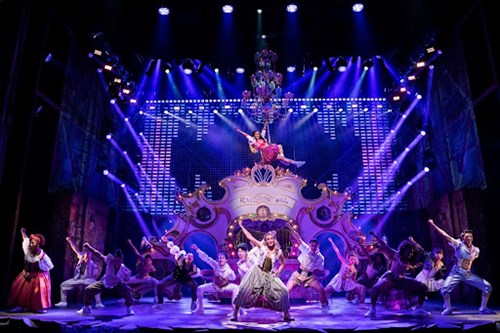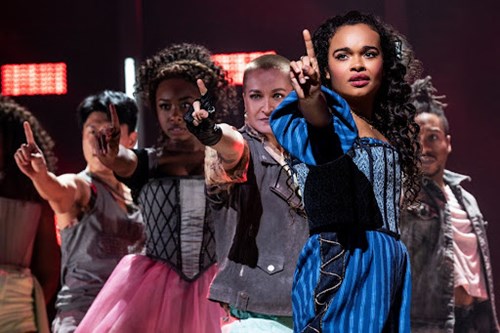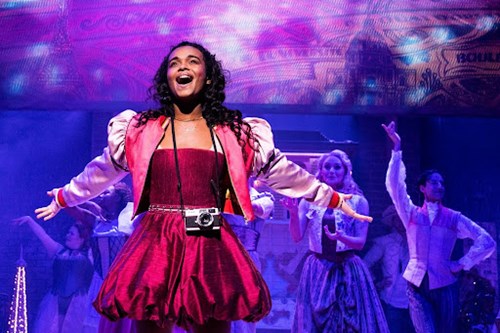
The character of Juliet Capulet, one of literature and theatre’s most enduring figures, has undergone various transformations over the centuries. So let’s delve into the evolution of Juliet, charting her journey from Shakespeare’s tragic heroine to the empowered protagonist of & Juliet on Broadway.
Shakespeare’s Romeo and Juliet, penned in the late 16th century, tells the tragic tale of two young lovers from feuding families in Verona, Italy. Juliet, a Capulet, falls deeply in love with Romeo, a Montague, leading to a whirlwind romance fraught with secrecy, defiance, and ultimately, tragedy. Despite their earnest efforts to be together, their love story ends in mutual suicide, becoming a timeless symbol of forbidden love and youthful passion.
Juliet Capulet is a character of significant importance in both literature and theatre. Initially, she was portrayed as a naive, obedient child who swiftly matures into a woman who defies societal norms for love. With time, Juliet’s character has been reinterpreted in numerous ways – from Franco Zeffirelli’s innocent teenager in the 1968 film to Baz Luhrmann’s rebellious Juliet in the 1996 adaptation of Romeo + Juliet. The latest and most groundbreaking interpretation is the modern musical & Juliet, which reimagines Juliet’s fate, giving her agency to control her destiny. This musical shifts the narrative focus from the ill-fated romance to Juliet’s personal growth and independence.

The long road to Broadway
In Shakespeare’s original play, Juliet is introduced as a dutiful and innocent 13-year-old girl, sheltered from the harsh realities of the world by her noble family. As the narrative progresses, Juliet transforms into a passionate and defiant young woman, willing to risk her life for her love for Romeo. This portrayal was not typical for its time, as it challenged the Elizabethan norms of female passivity and obedience.
The social and cultural norms of the Elizabethan era heavily influenced Juliet’s character. Women were expected to be modest, obedient, and submissive to their fathers and husbands. Juliet’s rebellion against these norms and her secret marriage to Romeo were acts of profound defiance and autonomy. They served as a critique of the oppressive societal norms and highlighted the tragic consequences of such rigid structures.
As we moved into the 20th century, Juliet’s character underwent a significant evolution, reflecting the changing societal norms and values. With the rise of feminism and women’s rights movements, Juliet’s character followed along, becoming even more progressive. She was no longer just a tragic heroine but a symbol of women’s resistance against patriarchal norms.
Key performances and adaptations in the 20th century further underscored this shift. In 1957, West Side Story, a modern-day musical adaptation of Romeo and Juliet, introduced Maria, a character based on Juliet. Unlike the original Juliet, Maria survives the tragedy, embodying resilience and strength in the face of adversity. Similarly, Franco Zeffirelli’s 1968 film adaptation featured a more passionate and assertive Juliet.

Juliet on the Modern Broadway Stage
The modern Broadway stage has recently witnessed an exciting reinterpretation of Juliet’s character through the innovative musical, & Juliet. This production boldly reimagines Juliet’s story, refusing to let her tale end in tragedy. Instead, & Juliet provides her with agency and independence, allowing her to control her own destiny.
In the show, Juliet’s character goes beyond the confines of Shakespeare’s tragic narrative. The musical begins where the original play ends, but instead of succumbing to grief, Juliet chooses life, embarking on a journey of self-discovery and independence. She evolves from a lovelorn teenager to a self-assured woman, challenging traditional gender norms and societal expectations. This newfound agency and independence are a significant departure from previous interpretations, providing a fresh and empowering take on Juliet’s character.
& Juliet serves as an important narrative for young girls navigating their own coming-of-age journeys. Unlike traditional interpretations that often portray Juliet as a tragic figure, the show reimagines her as an imperfect yet independent character who chooses life over death, resilience over despair. She embodies a spirit of defiance and determination that is both inspiring and empowering. As Juliet embarks on her journey of self-discovery and independence, she makes mistakes, faces challenges, and grapples with her emotions – experiences that every young girl can relate to. She is not flawless, and that’s what makes her relatable and inspiring. & Juliet sends a powerful message to young girls that it’s okay to be imperfect, that it’s okay to make mistakes, and that it’s okay to chart your own path. It encourages them to embrace their individuality, to question societal norms, and to be the authors of their own stories.
In her journey of embodying the character of Juliet in this groundbreaking musical, actress Lorna Courtney revealed that this role has been instrumental in her personal growth. She was deeply moved by the core message of the musical, which emphasizes authenticity, finding your voice and courageously expressing oneself. Courtney also highlighted another central theme of the show – the exploration of love in its many forms. This ranges from multigenerational love, the love among friends, found family, and the intricate dynamics of various relationships.

Courtney expressed that her favorite moment during the production is when Juliet takes center stage to perform the song “Roar”. She described this moment as her character’s pivotal scene of self-realization and empowerment, where Juliet truly finds her voice. She also shared her love for the sparkle and glitz that come with the role, particularly her dazzling costume during this scene. She likened the experience to being a pop star, complete with her rising on stage amidst a shower of confetti.
Each interpretation of Juliet’s character, while unique in its own right, is a product of its time, reflecting the societal norms and artistic innovations of the era. Despite the changes, Juliet remains a beloved and enduring figure in literature and theatre, her story continuing to resonate with audiences worldwide.
From the Elizabethan stage to the modern Broadway musical, Juliet Capulet has transformed from a dutiful daughter to a tragic heroine, and now to a symbol of female empowerment. This journey reflects the changing societal norms and artistic innovations over the centuries. Each interpretation, be it Shakespeare’s original play, 20th-century adaptations like West Side Story, or the recent Broadway musical & Juliet, offers a unique perspective on Juliet’s character, resonating with audiences in different ways.
Juliet’s enduring relevance lies in her adaptability. As societies evolve, so does Juliet, her character serving as a mirror to the changing times. Yet, at her core, she remains a passionate and defiant figure, her story a timeless testament to the power of love and the human spirit.
If you haven’t yet, make sure to see & Juliet on Broadway. It’s a groundbreaking production that offers a fresh and empowering perspective on Juliet’s story, pushing the boundaries of what we know and expect from this enduring character. As you watch the show, explore this new version of the beloved heroine and compare her to the earlier interpretations. How does Juliet resonate with you personally? How has your understanding of her character evolved over time? The story of Juliet is far from over; it continues to evolve, just like us.









